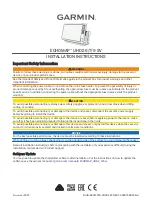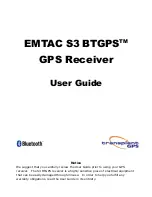
5-32
Rev 2
receiver collects data from its own memory to determine
which satellites should be visible. After completing the
initialization process the receiver begins the acquisition
process. During this time, the visible satellites are being
acquired and data from them is obtained.
The transition state indicates an adequate number of
satellites for navigation has been acquired and is being
tracked but no position data can yet be produced.
Normal navigation is indicated by a NAV, NAV A, or
NAV D GPS state. NAV A indicates that the altitude
input is being used in the position solution. NAV D indi-
cates that besides calculating position, the receiver is
collecting and storing in its memory additional data infor-
mation from the satellites (called ephemeris and
almanac data).
•
The specific GPS satellites or “space vehicles” (SV)
being received are displayed in the left column.
Each satellite has its own identification number. A *
symbol to the left of the satellite number indicates
that this particular satellite is not presently being
used in the navigation position solution.
•
The satellite’s “health” is indicated to the right of the
satellite number. This health information is transmit-
ted by the satellites:
B
bad
W
weak
-
unknown
blank good
F
fail
•
The signal-to-noise ratio (SNR) for each satellite
being received is displayed in the middle column and
indicates the signal strength for each satellite. The
higher the SNR value the stronger the signal.
Values usable for navigation will be in the mid 30s to
mid 50s; however, typical values are in the middle of
this range.
•
The elevation (ELE) above the horizon for each
satellite is provided in the right column and will range
from 0° to 90°.
5.8.2 Determining Estimated Position Error and
RAIM and FDE Availability (STA 2)
A representative Status 2 page is shown in figure 5-106.
On ORS 04 and later versions of the KLN 900, the STA
2 page displays the estimated position error and the cur-
rent RAIM and FDE status (figure 5-106A). On the ORS
01 and ORS 02 versions of the KLN 900, the STA 2
page displays just the estimated position error (figure 5-
106B). The position error and current RAIM and FDE
availability depend upon such factors as the number of
satellites being received, the strength of the GPS sig-
nals, and the geometry of the satellites presently being
used for navigation.
Figure 5-106B
ESTIMATED |
POSN ERROR |
.07nm|
|
|
|
STA 2
Figure 5-106A
ESTIMATED |
POSN ERROR |
.07nm|
RAIM YES |
FDE NO |
|
STA 2
Summary of Contents for KLN 900s
Page 1: ...Pilot s Guide KLN 900 Global Positioning System ORS 01 02 and 04 ...
Page 3: ...ii Rev 2 THIS PAGE INTENTIONALLY LEFT BLANK ...
Page 57: ...3 30 Rev 2 THIS PAGE INTENTIONALLY LEFT BLANK ...
Page 89: ...3 62 Rev 2 THIS PAGE INTENTIONALLY LEFT BLANK ...
Page 103: ...4 14 Rev 2 THIS PAGE INTENTIONALLY LEFT BLANK ...
Page 132: ...5 25 Rev 2 THIS PAGE INTENTIONALLY LEFT BLANK ...
Page 157: ...5 50 Rev 2 THIS PAGE INTENTIONALLY LEFT BLANK ...
Page 170: ...6 13 Rev 2 THIS PAGE INTENTIONALLY LEFT BLANK ...
Page 189: ...8 4 Rev 2 THIS PAGE INTENTIONALLY LEFT BLANK ...
Page 191: ...9 2 Rev 2 THIS PAGE INTENTIONALLY LEFT BLANK ...
Page 193: ...Rev 2 THIS PAGE INTENTIONALLY LEFT BLANK A 2 ...
Page 201: ...Rev 2 THIS PAGE INTENTIONALLY LEFT BLANK B 8 ...
Page 213: ...Rev 2 THIS PAGE INTENTIONALLY LEFT BLANK E 2 ...
Page 223: ...Rev 2 I 6 THIS PAGE INTENTIONALLY LEFT BLANK ...















































